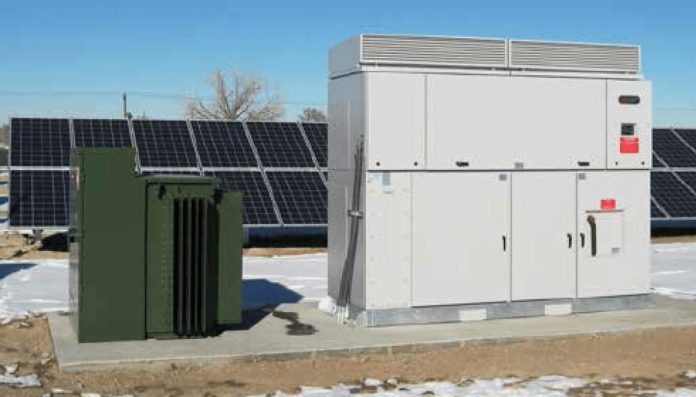A solar inverter is a type of electronic device that converts the direct current (DC) power generated by solar panels into alternating current (AC) power suitable for use in households and businesses. A typical solar panel only produces DC power, which cannot be used directly by most electrical devices. Therefore, it needs to be converted into AC power using a solar inverter.
There are two main types of solar inverters: string and microinverters. String inverters are installed at a centralized location and connected to multiple panels in a series or “string.” They typically cost less than microinverters but can suffer from efficiency losses if one panel is shaded or malfunctioning. Microinverters are individual units attached to each panel that convert DC to AC power at the source, thereby maximizing energy production and minimizing the impact of shading or other issues.
Solar inverters play an essential role in any solar energy system, as they ensure that the electricity produced by your panels can be used effectively and efficiently. It’s crucial to choose the right type of inverter for your specific needs, based on factors such as budget, size of your system, shading issues, and overall energy goals.
What is a solar inverter?
A solar inverter is an essential component of a solar energy system. It converts the direct current (DC) electricity generated by solar panels into alternating current (AC) electricity that can be used to power homes, businesses, and other electrical devices. Inverter technology has improved significantly in recent years, leading to greater efficiency and reliability.
There are three main types of solar inverters: string inverters, microinverters, and power optimizers. String inverters connect multiple solar panels together in a series, converting the DC electricity from the entire array into AC electricity. Microinverters are installed on each individual panel and convert DC to AC at each source. Power optimizers work similarly to microinverters but optimize the performance of each panel individually while still using a central inverter.
Inverters also provide important safety features for solar systems including monitoring grid voltage levels and disconnecting from the grid during power outages or maintenance events. With advancements in technology and increasing demand for renewable energy sources, it’s clear that inverters will continue to play a critical role in our transition towards cleaner energy alternatives like solar power.
How does a solar inverter work?
A solar inverter is an important component of a solar energy system. It converts the DC (direct current) electricity generated by the solar panels into AC (alternating current) power that can be used to power household appliances and feed back into the grid. There are three main types of inverters: string inverters, microinverters, and power optimizers.
The basic function of a solar inverter is to ensure that the output voltage and frequency from the solar panel array remain stable and match those of the utility grid. When sunlight strikes the photovoltaic cells on the panels, it generates DC electrical energy. The inverter takes this raw energy and runs it through an electronic circuit to convert it into usable AC electricity.
The process starts with a transformer that steps up or down the voltage as needed for transmission over long distances. Next, a series of switches called MOSFETs (metal-oxide-semiconductor field-effect transistors) convert DC to high-frequency AC before being filtered back down to low-frequency AC for use in homes or businesses. The final output is fed back into either your home’s electric distribution system or directly onto the grid via net metering agreements with your utility company.
Benefits of using a solar inverter
A solar inverter is an essential component of any solar panel system. It converts the direct current (DC) electricity generated by the solar panels into alternating current (AC) electricity that can be used to power household appliances and electronics. While a solar panel generates DC electricity, most of the devices we use at home require AC power.
No matter if you live in Adelaide, Inverloch or Wellington, one of the main benefits of using a solar inverter is its ability to reduce energy bills significantly. With a reliable solar inverter, homeowners can harness more energy from their photovoltaic panels and generate enough power to meet their daily needs. Another advantage of using a solar inverter is that it reduces carbon emissions, which contributes positively to environmental conservation efforts.
Moreover, some modern inverters are equipped with additional features such as monitoring software that allows users to track energy production in real-time and identify potential issues before they escalate. In summary, using a high-quality solar inverter has many benefits, including reducing energy costs, minimizing carbon footprint, and providing valuable insights into energy usage.
Conclusion: Importance of choosing the right inverter
A solar inverter is an essential component of any solar power system. Its main purpose is to convert the DC (direct current) electricity produced by solar panels into AC (alternating current) electricity that can be used by household appliances and fed back into the grid. Choosing the right inverter is crucial for maximizing energy efficiency and ensuring long-term performance.
One important factor to consider when selecting a solar inverter is its power rating. It needs to match the output of your solar panels, so it’s vital to choose an inverter that has a higher wattage than your PV system. Another key consideration is whether you want a string or micro inverter. String inverters are more cost-effective for larger systems, while micro-inverters provide greater flexibility and improved performance for smaller installations.
In conclusion, choosing the right solar inverter plays a critical role in maximizing energy efficiency and achieving optimal returns on investment from your PV system. With many options available on the market today, it’s essential to do your research and consult with an experienced installer before making any decisions about which type of inverter will best suit your needs and budget.



















